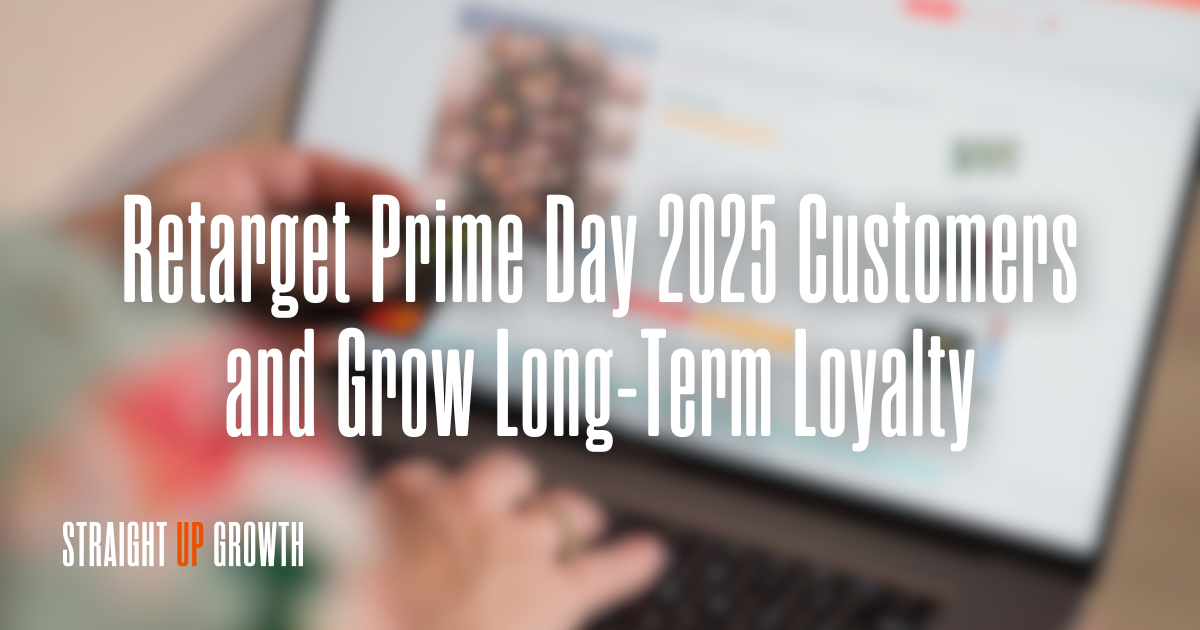Retarget Prime Day 2025 Customers and Grow Long-Term Loyalty

The spark of Prime Day 2025 is fueling what comes after. During this year's extended four-day event, from July 8-11, Amazon experienced significant growth. The first day alone saw online sales reach $7.9 billion, alongside an increase in overall brand discovery and conversion surges across the marketplace. Prime Day was a massive top-of-funnel win for brands. But for real growth, understanding the next steps is crucial.
It’s important not to let new customers go dormant after their first purchase. Personalized retargeting is essential to keep new customers active. Understanding purchasing behaviors can allow you to offer tailored content and promotions. In turn, this nurtures loyalty and boosts lifetime value.
In this blog, we’ll show you how to turn one-time buyers into long-term loyal customers.
1: Leverage Keyword Rankings to Guide Retargeting
Prime Day keyword rankings are essential for informing and guiding your retargeting strategies, both during and after the event. You gain valuable insights into what specifically drove traffic to your product page by tracking both organic and sponsored keyword rankings. Furthermore, monitoring high-intent search terms, such as "Amazon Prime Day 2025 clothing deals," allows you to understand precisely what products or promotions consumers were most interested in.
This data allows you to create highly targeted retargeting campaigns that show potential customers the exact products they viewed or searched for. You can significantly increase the relevance and effectiveness of your ads by aligning your retargeting efforts with keyword performance. This leads to higher conversion rates and a better ROI.
2: Build Effective Product and Category Remarketing Audiences
Post-Prime Day, you’ve got a unique window to re-engage shoppers while interest is still warm. Here’s how to segment effectively:
- Advertised Products Audiences: Reach customers who viewed or purchased your promoted SKUs.
- Amazon’s “Related to Advertised Products” Audiences: Leverage Amazon’s machine learning to find audiences who bought complementary items.
Start by focusing on your primary category audience, such as those who bought electronics during Prime Day. Then, expand your reach by experimenting with adjacent categories; for example, target customers who purchased phone cases if they bought new phones. To refine audiences, analyze purchase behavior, like repeat purchases, and engagement metrics, such as email clicks and website visits. Use this data to create tailored retargeting campaigns, offering specific promotions to those who have shown interest or loyalty, thereby maximizing conversion rates.
3: Customize Lookback Windows to Match Your Goals
There’s no one-size-fits-all when it comes to retargeting windows. Customize based on what you’re trying to achieve:
- 14-day window for retargeting specific products to drive repeat purchases while staying top of mind. Works well for consumables.
- 30-day window for cross-selling complementary or adjacent products. Great for lifestyle categories like wellness, supplements, and beauty.
To test different durations effectively, start with A/B testing: create two identical campaigns, each with a different lookback window, like 14 days vs. 30 days. Measure engagement by tracking key metrics such as:
- Click-Through Rate (CTR): Indicates how appealing your ads are.
- Conversion Rate: Shows how well your ads lead to purchases.
- Return on Ad Spend (ROAS): Measures the revenue generated per dollar spent.
Lastly, analyze these metrics to determine which lookback window performs best. Continuously refine your durations based on ongoing performance data to maximize ROI.
4: Optimize Bids for Your Objectives
Your bidding strategy should flex based on your campaign goals:
- Repeat Purchases and Loyalty: Use "Optimize for Conversions," which focuses on users most likely to buy again.
- Increase Brand Consideration or Awareness: Test "Optimize for Detail Page Views" or "Optimize for Viewable Impressions" to reach a broader audience and make your products more visible.
Shift bid strategies based on campaign performance and evolving business needs, such as switching to "Optimize for Conversions" during sales events to maximize immediate revenue.
5: Pro Tips to Maximize Retargeting ROI
To truly maximize your retargeting ROI, it's essential to implement proven strategies that keep your audience engaged and motivated to convert. Start by focusing on the following key areas:
- Refresh Creative Assets: Regularly update your ad creatives to combat ad fatigue and maintain engagement.
- Use Promo Codes/Subscribe & Save: Entice returning shoppers with promo codes or Subscribe & Save offers to encourage purchases.
- Leverage A/B Testing: Fine-tune ad copy and calls-to-action through A/B testing to optimize messaging effectiveness.
- Monitor Keyword Trends: Keep an eye on keyword trends after significant events like Prime Day to quickly adapt campaigns and capitalize on opportunities.
Conclusion
Most brands over-focus on Prime Day and under-leverage the momentum that follows. Your new customers are still in “discovery mode.” Use that window to turn high-intent shoppers into lifelong loyalists. Remember that retargeting isn’t just about short-term gains; it’s about nurturing customers into loyal advocates who will continue to support your brand. Want help building a full-funnel retargeting system that boosts repeat purchases, increases LTV, and drives profitability?
We do this every day for our Amazon clients, and we’ve got the data to back it up. Contact Straight Up Growth for a free audit, and let’s talk about what’s next!
Q+A
-What is the ideal lookback window for retargeting Prime Day customers who purchased seasonal items?
The ideal lookback window is typically 7-14 days. This shorter window ensures relevance to the immediate post-Prime Day period.
-How do I determine which keywords were most effective during Prime Day?
To determine effective keywords, analyze your ad platform's performance reports and focus on conversion rates and click-through rates. Identify terms with high engagement to refine your strategy.
-Can I cross-sell different products to my Prime Day customers?
Yes, you can cross-sell by analyzing purchase patterns to suggest complementary products or related items that enhance their initial purchase. Tailor these offers based on their Prime Day behavior.
-How soon after Prime Day should we launch our retargeting campaigns to maximize impact?
Launch your retargeting campaigns within 1-2 weeks after Prime Day to capitalize on the recent shopping experience. This ensures your brand stays top-of-mind while interest is still high.
-How do we measure whether our retargeting campaigns are working?
Measure campaign success by tracking conversion rates, return on ad spend (ROAS), and customer lifetime value (CLTV). Compare these metrics against your pre-campaign benchmarks.
-How do we tailor creatives for different retargeting segments?
Tailor creative by segmenting audiences based on their behavior, such as products viewed or purchased, and then personalize ad content accordingly. Use dynamic ads to show relevant products.




